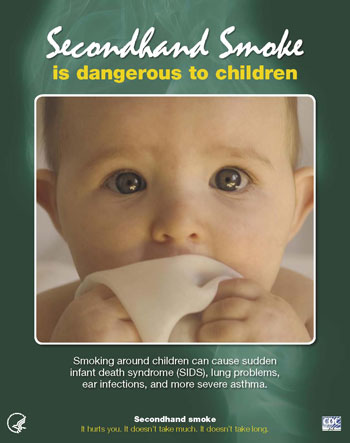
 May 3, 2010 - The research from the University of Rochester Medical Center is the first to examine whether housing type is a potential contributor to children’s exposure to cigarette smoke. It has been presented at the Pediatric Academic Society Meeting in Vancouver, Canada.
May 3, 2010 - The research from the University of Rochester Medical Center is the first to examine whether housing type is a potential contributor to children’s exposure to cigarette smoke. It has been presented at the Pediatric Academic Society Meeting in Vancouver, Canada.
PAPER: Tobacco Smoke Exposure among Children Living in Apartments, K.M. Wilson, J.D. Klein, A.K. Blumkin, M.A. Gottlieb, J.P. Winickoff. Pediatrics, University of Rochester, Rochester, NY; Julius B. Richmond Center of Excellence, American Academy of Pediatrics, Elk Grove Village, IL; Tobacco Control Resource Center, Northeastern University School of Law, Boston, MA; Pediatrics, Harvard Medical School, Boston, MA. Saturday, May 1, 2010, Platform Session: Environmental Health (8:00 AM - 10:00 AM) Pediatric Academic Society Meeting in Vancouver, Canada, May 1-4, 2010 ABSTRACT..
Among children who lived in an apartment, 84 percent had been exposed to tobacco smoke, according to the level of a biomarker (cotinine) in their blood that indicates exposure to nicotine found in tobacco, and this included more than 9 of 10 African-American and white children. Even among children who lived in detached houses, 70 per cent showed evidence of exposure.
"We are starting to understand the role that seepage through walls and through shared ventilation may impact tobacco smoke exposure in apartments," said Karen Wilson, M.D., MPH, author of the study and an assistant professor of Pediatrics at the University of Rochester Medical Center’s Golisano Children’s Hospital. "We see that children are being exposed in ways we are not picking up, and it’s important, for their health, that we figure out where this exposure is taking place, and work to eliminate it. Multi-unit housing is one potential source, but a very important one."
The study analyzed data from almost 6,000 children between 6- and 18-years-old in a national database (National Health and Nutrition Examination Survey 2001-2006) to see if there was any relationship between their smoke exposure and their housing type. Apartment living was associated with a 45 percent increase in cotinine levels for African American children and a 207 percent increase for white children. About 18 per cent of U.S. children live in apartments, and many of these children are living in subsidized housing communities where smoking is more prevalent.
Wilson said many parents are trying to limit their children’s tobacco smoke exposure by not allowing smoking in their apartments, but they say they can smell tobacco smoke coming from other apartments or from common areas.
Reference: Kids living with nonsmokers still exposed to smoke, ANI, The Times of India, 5/2/2010.
A few related news briefs:
Buffalo - landlords must disclose to tenants whether they allow smoking..;
Scotland - smokers will be banned from fostering or adopting children, comments from Professor Banzhaf..;
Poor children are exposed to more secondhand smoke than their wealthier counterparts..;
Father's Day and Third-Hand Smoke..;
Bringing the World of Tobacco Control closer together..
Children - apartments - parents do not smoke but still exposed to secondhand smoke..,
Subscribe to:
Post Comments (Atom)


To Provide Public Awareness
Purpose
About Us
Contact Us
2008 HIGHLIGHTS
TOPIX PAPERS - 2008 & 2009..
Archive
-
▼
2010 (1530)
-
▼
05/02 - 05/09 (31)
- U.S.- H.H.S. Secretary - Priorities: Prevent and ...
- New Zealand - revenue department has begun a revie...
- Missouri - one of the most tobacco-friendly state...
- British Columbia (B.C.), Canada - largest counte...
- Virginia - 1 of 3 teenagers identified smokeless ...
- Nigeria - call to emulate Australia's move to ban ...
- PMI - webcast May 13th - Goldman Sachs Consumer Pr...
- Philip Morris USA to raise prices by 8 cents/pack ...
- Lorillard , Inc. - to participate in the Goldman S...
- Kenya - BAT trying to find ways to circumvent law...
- African-American infants at increased risk from to...
- South Carolina - tobacco tax increase bill goes to...
- Romania - new strategy coming to cracking down on ...
- Netherlands - small bars can continue to ignore sm...
- World NO Tobacco Day, May 31, 2010..
- Bangladesh - tobacco companies targeting women, al...
- Turkey - even in tea houses smoking ban is working..
- FDA CTP - guidance on sale/distribution of to...
- South Carolina - state senate could send 50-cent ...
- Viet Nam - smokers, vendors think tobacco control...
- Australia - aboriginal medical services wants some...
- Qatar - people want better enforcement and strict...
- Brazil - plaintiff always loses in court cases br...
- FDA CTP next meeting Subcommittee of the Scienti...
- Ireland - Illicit tobacco trade booms..
- Switzerland - May 1st start of nationwide law sta...
- Canada - health groups want similar action like Au...
- Children - apartments - parents do not smoke but s...
- Vermont - Green Up Day - 40th Anniversary - major...
- New Zealand - increase in tobacco excise forced t...
- Greece - another increase in tobacco taxes can be ...
-
▼
05/02 - 05/09 (31)
© Copyright Notice: The content of this website is for information education purposes only and any newsbrief may be used only as "fair use" for information/education purposes with permission of the authors and providing that original references and associated reference links are included in HTML format.
0 comments:
Post a Comment